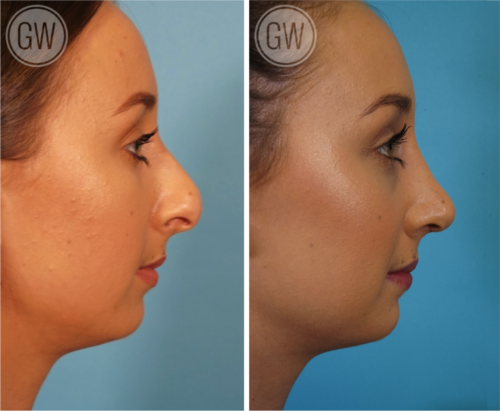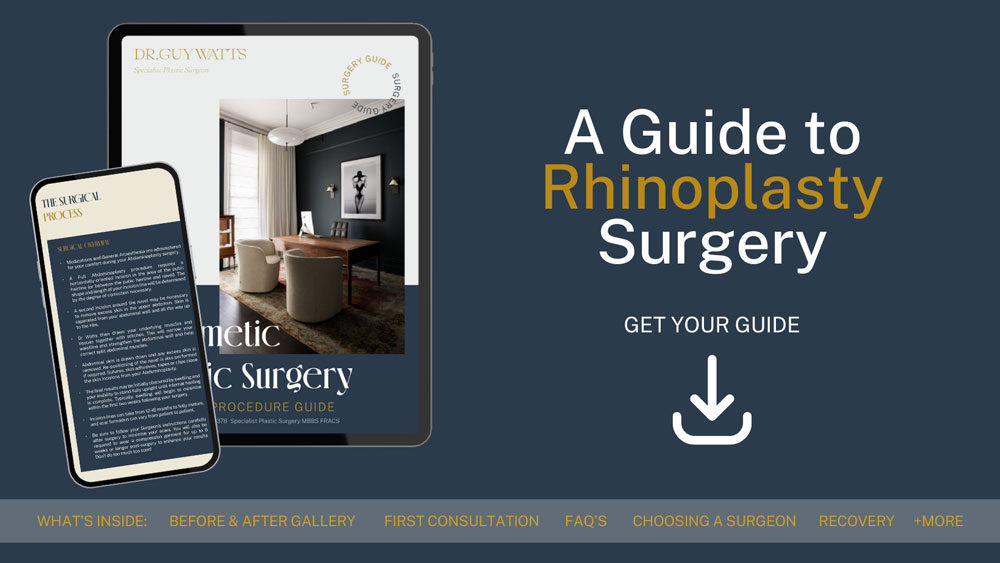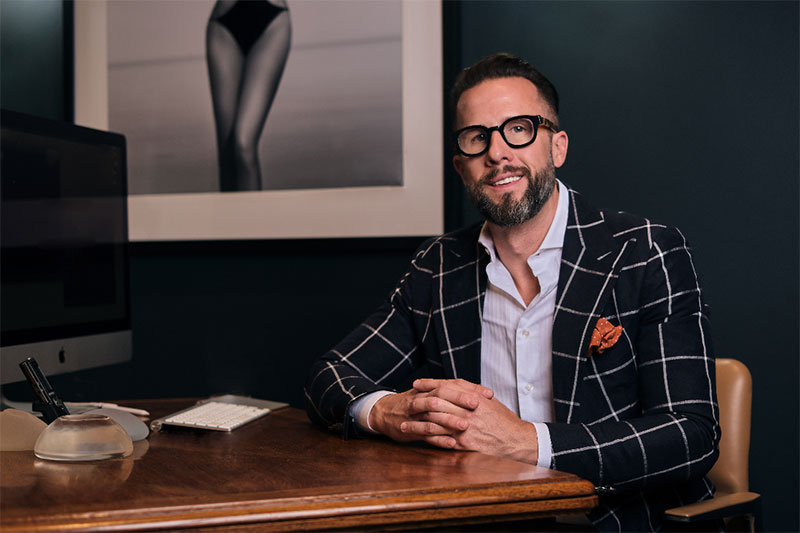
10 Aug Turkish Rhinoplasty
What Is Turkish Rhinoplasty, Benefits and Recovery
A Turkish Rhinoplasty refers to a specific technique or set of techniques used in nose reshaping (Rhinoplasty) that is tailored to address the unique anatomical features and aesthetic preferences commonly seen in Turkish individuals or those of similar ethnic backgrounds.
Dr. Guy Watts is recognised as one of Perth’s specialist plastic surgeons performing aesthetic plastic surgery. Rhinoplasty is among the various procedures Dr. Watts offers. Using a combination of techniques and a deep understanding of facial anatomy, Dr. Watts ensures that the reshaped nose harmonises with other facial features.
Take our quiz, and find out if you are ready for surgery
What Is Turkish Rhinoplasty?
Rhinoplasty is a plastic surgery procedure that modifies the structure of the nose for either aesthetic or functional reasons. Ethnic Rhinoplasty is a subset of this procedure that takes into account the unique anatomical and aesthetic characteristics of different ethnic groups, making sure results harmonises with the individual’s ethnic and cultural identity.
Turkish individuals, as with many Middle Eastern populations, might have specific nasal characteristics, such as:
- A prominent nasal hump
- Thick nasal skin
- A wide or bulbous nasal tip
- A longer nose
The aim of a Turkish Rhinoplasty is to address these characteristics (if desired) by you (the patient), while maintaining an appearance that is in harmony with your other facial features and preserves your ethnic identity.
As with any Rhinoplasty, the goals and techniques should be discussed in detail with a specialist plastic surgeon who has experience in Ethnic Rhinoplasties and understands the nuances of the patient’s desires and anatomical needs.
DOWNLOAD DR WATTS’ ULTIMATE GUIDE TO RHINOPLASTY

How Is Turkish Rhinoplasty Performed?
The specifics of a Turkish Rhinoplasty, like any other Rhinoplasty, depend on the individual’s anatomy and the desired outcome. However, when addressing common features found in many Turkish noses, the following techniques or steps might be implemented:
Consultation
Before the procedure, a detailed consultation with the plastic surgeon is necessary. The plastic surgeon will evaluate your facial structure, nasal anatomy, and discuss the desired outcome.
Incision
There are two main approaches to Rhinoplasty:
- Open Rhinoplasty: Your plastic surgeon makes an incision across the columella (the soft tissue between the nostrils). This approach provides better visibility and access to the nasal structures.
- Closed Rhinoplasty: All incisions are made inside the nostrils. This method leaves no visible scarring but offers less direct access to certain nasal structures.
Nasal Hump Reduction
One of the common features in many Turkish noses is a pronounced dorsal hump. Your plastic surgeon may reduce the bony and cartilaginous hump with specific tools. This process can involve filing down the bone and cartilage or making precise cuts.
Altering the Tip
If the nasal tip is bulbous or wide, your plastic surgeon might reshape the tip cartilages. Suture techniques or cartilage removal can be used to alter the tip and increase its definition.
Osteotomies
To narrow the nasal bones or to close the “open roof” after hump removal, your plastic surgeon might perform controlled fractures, known as osteotomies.
Alar Base Reduction
If the nostrils are flared or too wide, an alar base reduction can be performed. This involves removing small wedges of tissue at the base of the nostrils.
Septal Work
In cases where there is a deviated septum or other internal obstructions, your plastic surgeon may alter these issues to increase your ability to breath.
Repositioning and Shaping
Once the necessary alterations are made, the nasal skin and soft tissues are redraped over the new framework. Your plastic surgeon then meticulously shapes the nose to achieve the desired appearance.
Closure
The incisions are closed using fine sutures. If an open approach was used, the small scar on the columella usually heals well and becomes inconspicuous with time.
Recovery
After the surgery, your nose might be splinted or packed to maintain its new shape and reduce swelling. You will need to avoid strenuous activities for several weeks and follow post-operative care instructions diligently.
It’s crucial for patients interested in a Turkish Rhinoplasty to find a specialist plastic surgeon with experience in Ethnic Rhinoplasties. The goal is to achieve a result that maintains or increases the person’s ethnic identity while addressing any aesthetic or functional concerns.
Tips for Optimal Recovery after Turkish Rhinoplasty
Recovering from a Turkish Rhinoplasty, as with any Rhinoplasty procedure, requires patience, care, and adherence to post-operative instructions. Proper aftercare can influence the final result and help avoid complications. Here are some tips for optimal recovery after a Turkish Rhinoplasty:
Follow Your Plastic Surgeon’s Instructions
Always adhere to the post-operative care guidelines provided by your plastic surgeon.
Rest and Sleep Elevated
For the first few days post-surgery, keep your head elevated, even when sleeping. This can help reduce swelling.
Avoid Strenuous Activities
Refrain from heavy lifting, bending over, and vigorous exercises for several weeks or as advised by your plastic surgeon.
Limit Facial Movements
Try to reduce facial expressions that can put strain on the surgical site.
Cold Compress
Use a cold compress around the eyes and cheeks to help reduce swelling and provide relief.
No Glasses
Avoid wearing regular glasses or sunglasses that rest on the bridge of the nose for the first few weeks. This can interfere with the healing process.
Keep Nasal Passages Moist
Your plastic surgeon might recommend saline sprays or ointments to keep the inside of the nose moist, especially if they performed internal work.
Avoid Blood Thinners
Refrain from taking blood-thinning medications, herbal supplements, and certain vitamins unless approved by your plastic surgeon. These can increase the risk of bleeding.
Limit Sun Exposure
The operated nose will be more sensitive to the sun. Protect it from prolonged sun exposure, which can cause discolouration or excessive swelling. Use sunscreen if you need to be out in the sun.
Avoid Alcohol and Smoking
Alcohol can increase swelling, while smoking restricts blood flow, which can slow the healing process. Both should be avoided.
Stay Hydrated
Drinking plenty of water can facilitate the healing process.
Maintain Good Nasal Hygiene
If instructed, softly clean the outside of your nostrils with a Q-tip soaked in hydrogen peroxide or saline solution to prevent crusting.
Have Patience
It’s important to remember that the final results of a Rhinoplasty may take up to a year or more to fully manifest, as the swelling subsides and the nose settles into its new shape.
Attend Follow-up Appointments and Communicate
Make sure you go to all post-operative check-ups so your plastic surgeon can monitor your healing progress. It’s essential to maintain open communication with your plastic surgeon throughout the recovery process. If you have concerns or notice anything unusual, reach out to your medical team immediately.
Why to Avoid Traveling Abroad to Get Plastic Surgery
Traveling abroad for plastic surgery, often referred to as “medical tourism,” has become increasingly popular due to advertised cost savings and the allure of having multiple medical procedures performed at once whilst on vacation. However, there are several important considerations to keep in mind when thinking about undergoing plastic surgery abroad:
Accreditation and Standards
Not all countries maintain the same rigorous standards for medical facilities and surgical training as Australia. The Australian health system is renowned for its high standards, strict regulations, and well-trained surgeons. When traveling abroad, it might be challenging to verify the credentials, training, and competency of surgeons and clinics.
Risks of Surgery
Every surgery carries inherent risks, including complications such as infection, bleeding, and anaesthesia reactions. When these complications occur far from home, it can be both emotionally and financially taxing.
Post-operative Care
Successful outcomes in plastic surgery are not just about the operation itself but also about the post-operative care. If complications arise after returning to Australia, it may be difficult to consult with the overseas surgeon, and local doctors might be hesitant or might not have all the necessary information to provide optimal care.
Travel Risks Post-Surgery
Traveling, especially flying, soon after surgery can increase the risk of complications. For example, long flights can raise the risk of deep vein thrombosis (DVT).
Communication Barriers
Language barriers can lead to misunderstandings about the procedure, risks, and post-operative care. Proper communication is crucial when discussing surgical expectations and outcomes.
Different Medical and Legal Systems
If something goes wrong during or after the surgery, seeking legal recourse in another country can be complex and often unsuccessful. Understanding and navigating another country’s medical malpractice laws can be challenging.
Additional Costs
While the surgery itself might be cheaper, other costs can add up, such as travel, accommodation, post-operative care, and potential treatments for complications. If complications arise, the additional medical costs, coupled with the costs of extended stay and return travel, can negate any initial savings.
Family Support
Being in a foreign country, away from family and friends, can be isolating if recovery becomes challenging.
Cultural Differences
Cultural standards can vary. A procedure deemed popular and standard in one country might not align with an individual’s personal or cultural aesthetic preferences.
Inadequate Follow-Up
Regular follow-ups are vital after plastic surgery. Being thousands of miles away from the operating surgeon makes consistent follow-up appointments difficult.
FAQs about Turkish Rhinoplasty
What is the difference between a traditional Rhinoplasty and a Turkish Rhinoplasty?
- A traditional Rhinoplasty is a general term for a surgical procedure that modifies the structure of the nose for aesthetic or functional reasons.
- A Turkish Rhinoplasty, on the other hand, refers to techniques specifically tailored to address the unique anatomical features and aesthetic preferences common in Turkish individuals or those of similar ethnic backgrounds. It’s a subset of Ethnic Rhinoplasty focused on preserving the patient’s ethnic identity.
How long is the recovery period after a Rhinoplasty?
- Recovery after Rhinoplasty varies among individuals.
- Generally, most patients experience bruising and swelling for about 10-14 days.
- You might need to wear a nasal splint during the first week.
- While many people return to work or school within two weeks, it’s crucial to avoid strenuous activities for at least 3-6 weeks.
- Complete healing and settling of the nasal tissues can take up to a year or more.
Can Rhinoplasty increase my breathing?
- Yes, Rhinoplasty can address functional issues.
- If you have a deviated septum or other structural problems that obstruct airflow, a Septoplasty (often performed alongside a Rhinoplasty) can be performed to increase nasal breathing.
Are the results of a Turkish Rhinoplasty permanent?
- The results of a Turkish Rhinoplasty are long-lasting. But it’s important to note that the nose, like other parts of the body, can undergo changes due to ageing, injuries, or other factors.
- While the fundamental changes from the surgery remain, subtle alterations may occur over the years.
Are there non-surgical alternatives to Rhinoplasty or Turkish Rhinoplasty?
- Yes, there are non-surgical nose surgery options like Volumising treatments that can make temporary adjustments to the nose’s appearance.
- These injections can alleviate the appearance of slight bumps and ridges, alter the nasal tip, or make other subtle changes. However, these non-surgical treatments are temporary (lasting from several months to a couple of years) and there are limits to the changes they can achieve in comparison to surgical Rhinoplasty.
Further Reading about Nose Procedures with Dr. Guy Watts
- Read Dr. Watts’ Rhinoplasty Surgery Page
- Read Dr. Watts’ Nasal Reconstruction Surgery Page
- Read Dr. Watts’ Non-surgical Rhinoplasty Surgery Page
- See Dr. Watts’ Rhinoplasty Galleries
- Read Dr. Watts’ Blog about Nose Shapes and the Different Types
- Read Dr. Watts’ Blog about How to Reduce Bruising after Rhinoplasty
- Read Dr. Watts’ blog about Recovery after Nose Surgery
- Read Dr. Watts’ blog about What is a Deviated Septum?
- Read Dr. Watts’ blog about What is a Dorsal Hump?
Medical References and Studies about Turkish Rhinoplasty
About Dr. Guy Watts – MED0001539378
FRACS (Plas) – Specialist Plastic Surgeon In Perth WA
Dr. Guy Watts is a Specialist Plastic Surgeon (AHPRA MED0001539378) with an extensive career that spans across renowned plastic surgery clinics worldwide. His experience has been honed through invaluable experiences at esteemed establishments such as the New York Eye and Ear Infirmary and the renowned Pitanguy Clinic in Brazil.
Having collaborated with the foremost cosmetic plastic surgeons on a global scale, Dr. Watts has chosen to return to Perth after a 17-year journey of intensive training and invaluable professional experience to bring the latest practices and technology in cosmetic plastic surgery to his patients.
Dr. Watts is a Fellow of the Royal Australasian College of Surgeons (FRACS) and a Member of the Australian Society of Plastic Surgeons (ASPS), Australasian Society of Aesthetic Plastic Surgeons (ASAPS) and the International Society of Aesthetic Plastic Surgeons (ISAPS).
Read about the potential Risks and Complications of Surgery
Read the Patient Information and Resources
About CLINISPA
Clinispa is Dr Watts’ bespoke medical clinic performing Cosmetic Aesthetic treatments. At Clinispa, we offer advanced clinical treatments in a luxurious and calming environment, tailored to support your skin’s health and appearance.
Clinispa aesthetic services are performed by Dr Guy Watts’ nursing professionals, who have a passion for and solid understanding of facial aesthetics.
All Clinispa clients are considered individually, with a personalised treatment plan consisting of advanced scientific approaches to cosmetic aesthetics. We incorporate innovative technologies in conjunction with superiorly formulated skin care.
For more information about the full range of Clinispa Aesthetic of Cosmetic Treatments visit the Clinispa website








Sorry, the comment form is closed at this time.